• Leyland and then Leyland Daf has always had a
Page 22
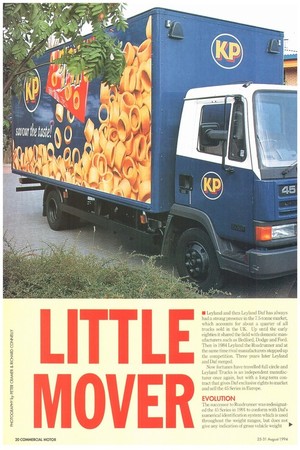
Page 24
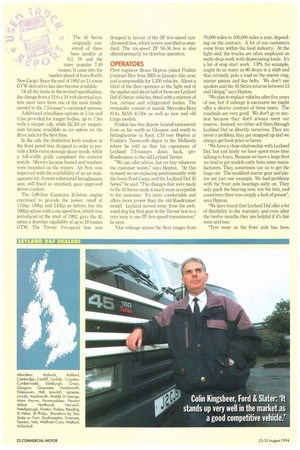
Page 25
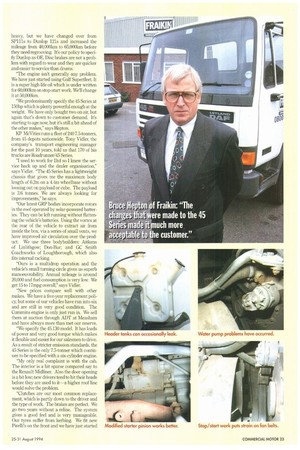
Page 26
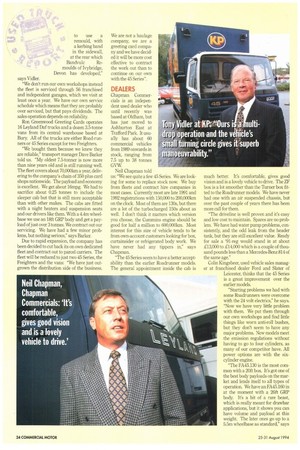
Page 27
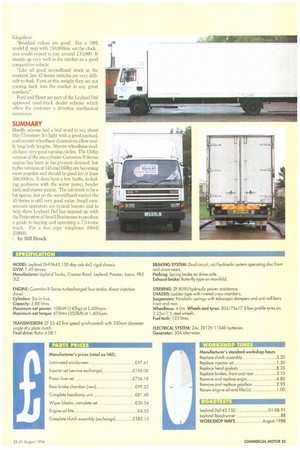
If you've noticed an error in this article please click here to report it so we can fix it.
strong presence in the 7.5-tonne market, which accounts for about a quarter of all trucks sold in the UK. Up until the early eighties it shared the field with domestic manufacturers such as Bedford, Dodge and Ford. Then in 1984 Leyland the Roadrunner and at the same time rival manufacturers stepped up the competition. Three years later Leyland and Daf merged.
Now fortunes have travelled full circle and Leyland Trucks is an independent manufacturer once again, but with a long-term contract that gives Daf exclusive rights to market and sell the 45 Series in Europe.
EVOLUTION
The successor to Roadrunner was redesignated the 45 Series in 1991 to conform with Dafs numerical identification system which is used throughout the weight ranges, but does not give any indication of gross vehicle weight The 45 Series originally con sisted of three base models at 6.2, 10 and the more popular 749 tonnes. It came into the market ahead of Iveco Fords New Cargo. Since the end of 1992 an 11-tonne GVW derivative has also become available, Of all the items in the revised specification, the change from a 12 to a 24 volt electrical system must have been one of the most fundamental to the 7.5-tonner's continued success.
Additional wheelbase options at 5.1m and 5.5m provided for longer bodies, up to 7.3m with a sleeper cab, while ECAS air suspension became available as an option on the drive axle for the first time.
In the cab, the distinctive kerb window in the front panel was dropped in order to provide a little extra stowage space inside, while a full-width grille completed the exterior restyle. Mirrors became heated and washers were mounted on the wipers Air flow was improved with the availability of an air management kit. A more substantial Isringhausen seat, still fixed as standard, gave improved driver comfort.
The 5.88-litre Cummins B-Series engine continued to provide the power, rated at 115hp, 130hp and 145hp as before, but the 160hp option with a six-speed box, which was introduced at the start of 1992, gave the 45 series a drawbar capability of up to 18 tonnes GTW. The Turner five-speed box was
dropped in favour of the ZF five-speed synchromesh box, which is now specified as standard. The six-speed ZF S6-36 box is also offered primarily for drawbar operation.
OPERATORS
Fleet engineer Bruce Hepton joined Fraikin Contract Hire from BRS in January this year, and is responsible for 1,350 vehicles. About a third of the fleet operates at the light end of the market and about half of those are Leyland Daf 45 Series vehicles, fitted with a mixture of box, curtain and refrigerated bodies. The remainder consist of mainly Mercedes-Benz 814s, MAN 8.150s as well as new and old Cargo models.
Fraikin has five depots located nationwide from as far north as Glasgow and south to Sit-tingbourne in Kent. CM met Hepton at Fraikin's Tamworth depot in the Midlands where he told us that his experience of Leyland 7.5-tonners dates back, preRoadrunner, to the old Leyland Terrier.
"We can offer advice, but we buy whatever the customer wants," says Hepton. "At this moment we are replacing predominantly with the lveco Ford Cargo and the Leyland Daf 45 Series" he said. "The changes that were made to the 45 Series made it much more acceptable to the customer. It's more comfortable and offers more power than the old Roadrunner model. Leyland moved away from the awkward dog-leg first gear in the Turner box to a very easy to use ZF five-speed transmission," he says.
"Our mileage across the fleet ranges from 70,000 miles to 100,000 miles a year, depending on the contract. A lot of our customers come from within the food industry. At the light end, the trucks are often employed on multi-drop work with depreciating loads. It's a lot of stop start work. UPS, for example, might do as many as 80 drops in a shift and that certainly puts a load on the starter ring, starter pinion and fan belts. We don't use spoilers and the 45 Series returns between 12 and 14mpg," says Hepton.
"We plan to replace vehicles after five years of use, but if mileage is excessive we might offer a shorter contract of three years. The residuals are very good. We don't go to auction because they don't always meet our reserve. Instead, we either sell them through Leyland Daf or directly ourselves. They are never a problem, they get snapped up and we always get book price or better.
"We have a close relationship with Leyland Daf, but just lately we have spent more time talking to Iveco. Because we have a large fleet we tend to get models early from some manufacturers. They sometimes use us to get the bugs out. The modified starter gear and pinion are just one example. We had problems with the front axle bearings early on. They only pack the bearing now, not the hub, and sometimes there was simply a lack of grease", says Hepton.
"We have found that Leyland Daf offer a lot of flexibility in the warranty and even after the twelve months they are helpful if it's fair wear and tear.
"Tyre wear on the front axle has been heavy, but we have changed over from SP111s to Dunlop 121s and increased the mileage from 40,000km to 65,000km before they need regrooving. It's our policy to specify Dunlop as OE. Disc brakes are not a problem with regard to wear and they are quicker and easier to service than drums, "The engine isn't generally any problem. We have just started using Gulf Superfleet. It is a super high-life oil which is under written for 60,000km on stop-start work. We'll change it at 50,000km.
We predominantly specify the 45 Series at 150hp which is plenty powerful enough at the weight. We have only bought two on air, but again that's down to customer demand. It's starting to age now, but it's still a bit ahead of the other makes," says Hepton.
KP McVities runs a fleet of 240 7.5-tonners, from 45 depots nationwide. Tony Vidler, the company's transport engineering manager for the past 10 years, told us that 170 of his trucks are Roadrunner/45 Series.
"I used to work for Oaf so I knew the service back up and the dealer organisation," says Vidler. The 45 Series has a lightweight chassis that gives me the maximum body length of 6.2m on a 4.4m wheelbase without loosing out on payload or cube. The payload is 3.6 tonnes. We are always looking for improvements," he says,.
Our latest GRP bodies incorporate rotors in the roof operated by solar-powered batteries. They can be left running without flattening the vehicle's batteries. Using the vortex at the rear of the vehicle to extract air from inside the box, via a series of small vents, we have improved air circulation over the product. We use three bodybuilders: Aitkens of Linlithgow; Don-Bur; and GC Smith Coachworks of Loughborough, which also fits internal racking, "Ours is a multidrop operation and the vehicle's small turning circle gives us superb manoeuvrability. Annual mileage is around 20,000 and fuel consumption is very low. We get 15 to 17mpg overall," says Vidler.
"New prices compare well with other makes. We have a five-year replacement policy, but some of our vehicles have run into six and are still in very good condition. The Cummins engine is only just run in. We sell them at auction through ADT at Measham and have always more than met our reserve.
We specify the 45.130 model. It has loads of power and very good torque which makes it flexible and easier for our salesmen to drive. As a result of stricter emission standards, the 45 Series is the only 7.5-tormer which continues to be specified with a six-cylinder engine.
"My only real complaint is with the cab. The interior is a bit sparse compared say to the Renault Midliner. Also the door opening is a bit low; new drivers tend to hit their heads before they are used to it—a higher roof line would solve the problem.
"Clutches are our most common replacement, which is partly down to the driver and the type of work. The brakes are perfect. We go two years without a reline. The system gives a good feel and is very manageable. Our tyres suffer from kerbing. We -fit new Pirelli's on the front and we have just started
to use a remould, with a kerbing band in the sidewall, at the rear which
Bandvulc Remoulds of Ivybridge, Devon has developed,"
says Vidler.
"We don't run our own workshops instead the fleet is serviced through 56 franchised and independent garages, which we visit at least once a year. We have our own service schedule which means that they are probably over serviced, but that pays dividends. The sales operation depends on reliability Ron Greenwood Greeting Cards operates 16 Leyland Daf trucks and a dozen 3.5-tonne vans from its central warehouse based at Bury. All of the trucks are either Road-runners or 45 Series except for two Freighters.
"We bought them because we knew they are reliable," transport manager Dave Barker told us. "My oldest 7.5-tonner is now more than nine years old and is still running well. The fleet covers about 70,000km a year, delivering to the company's chain of 350 plus card shops nationwide. The payload and economy is excellent. We get about 16mpg. We had to sacrifice about 0.25 tonnes to include the sleeper cab but that is still more acceptable than with other makes. The cabs are fitted with a night heaters and suspension seats and our drivers like them. With a 4.4m wheelbase we use an 18ft GRP body and get a payload of just over 3 tonnes. We contract out our servicing. We have had a few minor problems, but nothing serious," says Barker.
Due to rapid expansion, the company has been decided to cut back its on own dedicated fleet and contract out to parcel carriers. The fleet will be reduced to just two 45 Series, the Freighters and the vans: "We have just outgrown the distribution side of the business. We are not a haulage company, we are a greeting card company and we have decided it will be more cost effective to contract the work out than to continue on our own with the 45 Series".
DEALERS
Chapman Commercials is an independent used dealer who until recently was based at Oldham, but has just moved to Ashburton East at Trafford Park. It usually has about 60 commercial vehicles from 1989 onwards in stock, ranging from 7.5 up to 38 tonnes GVW Neil Chapman told us: "We see quite a few 45 Series. We are looking for some to replace stock now. We buy from fleets and contract hire companies in most cases. Currently most are late 1991 and 1992 registrations with 150,000 to 200,000km on the clock. Most of them are 130s, but there are a lot of the turbocharged 150s about as well. I don't think it matters which version you choose, the Cummins engine should be good for half a million to 600,000km. Most interest for this size of vehicle tends to be from own-account customers looking for box, curtainsider or refrigerated body work. We have never had any tippers in," says Chapman.
"The 45 Series seem to have a better acceptability than the earlier Roadrunner models. The general appointment inside the cab is much better. It's comfortable, gives good vision and is a lovely vehicle to drive. The ZF box is a lot smoother than the Turner box fitted to the Roadrunner models. We have never had one with an air suspended chassis, but over the past couple of years there has been more call for them.
"The driveline is well proven and it's easy and low cost to maintain. Spares are no problem. We have had water pump problems, consistently, and the odd leak from the header tank, but they are still excellent value. Ready for sale a '91-reg would stand in at about .£13,000 to £14,000 which is a couple of thousand pounds less than a Mercedes-Benz 814 of the same age."
Cohn Kingsbeer, used vehicle sales manager at franchised dealer Ford and Slater of Leicester, thinks that the 45 Series is a great improvement over the earlier models.
''Starting problems we had with some Roadrunners were overcome with the 24 volt electrics," he says. "Now we have very little problemn with them. We put them through our own workshops and find little things like worn anti-roll bushes, but they don't seem to have any major problems. New models meet the emission regulations without having to go to four cylinders, as many of our competitor have. All power options are with the sixcylinder engine_
"The FA45.130 is the most common with a 20ft box. Is got one of the best body payloads on the market and lends itself to all types of operation. We have an FA45.160 in at the moment with a 26ft GRP body It's a bit of a rare beast, which is really meant for drawbar applications, but it shows you can have volume and payload at this weight. The later ones go up to a 5,5m wheelbase as standard," says
kingsbeer.
"Residual values are good, For a 1991 model (j. reg) with 150,000km on the clock, you would expect to pay around 1:15,000. It stands up very well in the market as a good competitive vehicle.
"Like all good secondhand stock at the moment, late 45 Series vehicles are very difficult to find. Even at this weight they are not coming back into the market in any great numbers".
Ford and Slater are part of the Leyland Daf approved used-truck dealer scheme which offers the customer a driveline mechanical assurance,
SUMMARY
Hardly anyone had a had word to say about this 7.5-tormer. It's light with a good payload, and current wheelbase dimensions allow really long body lengths. Shorter wheelbase models have very good turning circles. The 130hp version of the six-cylinder Cummins B-Series engine has been in the greatest demand, but turbo versions at 145 and 160bp are becoming more popular and should be good for at least 500,000km. It does have a few faults, including problems with the water pump, header tank and starter pinion. The cab tends to be a bit sparse, but on the secondhand market the 45 Series is still very good value. Small ownaccount operators are typical buyers and to help them Leyland Daf has teamed up with the Federation of Small Businesses to produce a guide to buying and operating a 7.5-tonne truck. For a free copy telephone: (0844) 218660.
by Bill Brock
















































































